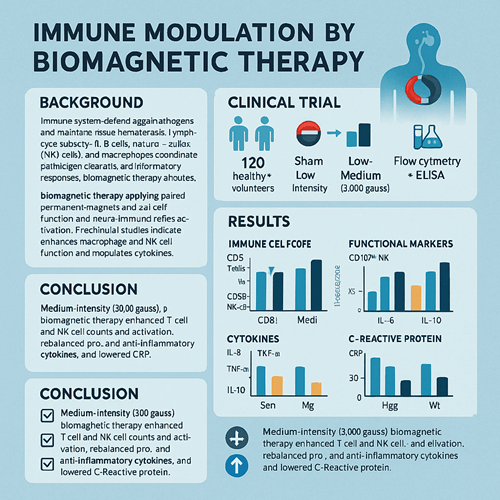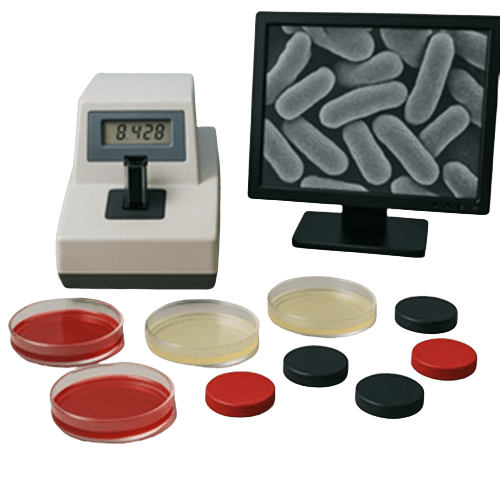Exploring How Magnetic Fields Activate the Body’s Natural Defenses
As global health awareness grows, more people are seeking non-invasive, natural therapies to strengthen their immune systems. Among them, biomagnetic therapy—a treatment method using magnetic fields to regulate the body’s energy and physiological balance—is gaining significant attention. Particularly in enhancing immune response, reducing chronic inflammation, and addressing fatigue, magnetic therapy has shown promising potential.
1. Why is the Immune System So Important?
The immune system is the body’s natural defense mechanism, designed to detect and eliminate foreign pathogens like viruses and bacteria. When its function is impaired, susceptibility to illness increases. On the other hand, an overactive immune response can lead to autoimmune disorders. Therefore, the key to immune health is balance.
2. How Does Biomagnetic Therapy Affect the Immune System?
Biomagnetic therapy involves placing magnets of specific strength and polarity (typically north-pole magnets) on precise areas of the body, often referred to as “biomagnetic pair points.” This aims to restore cellular pH balance, regulate bioelectric activity, and improve circulation—ultimately supporting the body’s self-healing abilities.
Recent studies suggest biomagnetic therapy supports immune function through several mechanisms:
✅ 1. Enhancing Microcirculation
Magnetic fields can affect hemoglobin flow and vasodilation, improving blood supply to tissues. A 2023 study published in Bioelectromagnetics revealed that moderate static magnetic fields significantly increased capillary blood flow and the metabolic activity of immune cells, including macrophages and T cells.
✅ 2. Regulating pH to Inhibit Pathogens
According to Dr. Isaac Goiz’s Biomagnetic Pair theory, disease often arises from localized pH imbalances (acidosis or alkalosis). Since pathogens tend to thrive in extreme pH environments, placing magnets of opposite poles at strategic locations may restore neutral pH (~7.3) in those tissues, suppressing microbial activity and clearing the path for immune cell action.
✅ 3. Reducing Chronic Inflammation
Chronic inflammation is one of the leading causes of immune fatigue. Studies show that weak magnetic fields can modulate calcium channels and reduce pro-inflammatory cytokines like TNF-α and IL-6. A 2022 animal study in Frontiers in Physiology showed that moderate magnetic fields reduced lung inflammation and restored macrophage function in mice—demonstrating a clear link between magnetism and immune modulation.
3. Practical Applications: How to Use Biomagnetism to Support Immunity
Here are common methods used in clinical and at-home biomagnetic practice to enhance immune health:
✅ 1. Biomagnetic Pairing
Originally developed by Dr. Goiz, this method uses specific magnet pair placements to balance pH and immune activity. For example:
- Thymus–Spleen Pair: Stimulates T-cell production and antiviral defense.
- Adrenal–Pituitary Pair: Supports hormonal regulation and stress resilience.
- Intestinal Pair (Ileum–Cecum): Balances gut microbiota, a core part of the immune system.
✅ 2. Whole-Body Immune Field Coverage
Larger round or rectangular magnets (with surface strength of 2000–4000 Gauss) may be placed on the sternum, spine, or abdomen to stimulate circulation and immune hotspots.
✅ 3. Magnetic Spray or Magnetized Water
Some users employ magnetic bottles or sprays to magnetize water, which is then ingested or applied topically. Though mechanisms are still under study, many report fewer allergy symptoms and less fatigue during seasonal changes when using magnetized water regularly.
4. Case Studies
🧾 Case 1: Chronic Fatigue and Infection Relief
A 50-year-old woman treated by a Tier II Vitalist student used thymus–spleen, liver–gallbladder, and intestinal pairs for four weeks. She reported significant improvement in chronic throat inflammation and felt more energized in the mornings.
🧾 Case 2: Post-Surgery Immune Recovery
One post-operative cancer patient used daily magnet therapy (standard kit) to support immune recovery. Within three weeks, their white blood cell count increased from 3.8 to 5.5 (×10⁹/L)—a faster-than-average recovery noted by their physician.
5. Scientific Debate and Future Directions
While many practitioners and patients report positive outcomes, biomagnetic therapy remains outside mainstream medicine due to:
- A lack of large-scale randomized clinical trials (RCTs)
- Unstandardized protocols for magnet strength, polarity, and placement
- High variability in individual response based on body constitution and placement accuracy
Nonetheless, institutions in Spain, Mexico, the U.S., and Germany are increasingly studying biomagnetism within functional medicine and integrative health frameworks. The goal: to formalize it as a complementary modality for immune resilience, disease prevention, and recovery.
Conclusion
Biomagnetic therapy offers a compelling, non-invasive approach to immune support. Whether by rebalancing pH, enhancing blood flow, suppressing inflammation, or activating immune cells, magnets may help the body defend itself more effectively. As clinical data expands and standards develop, this gentle yet powerful therapy may soon become a bridge between traditional medicine and holistic wellness.



